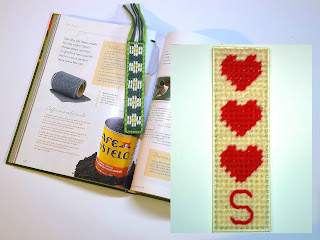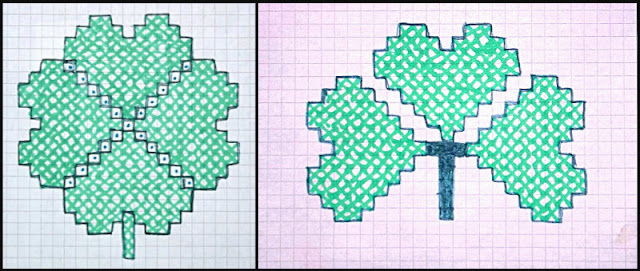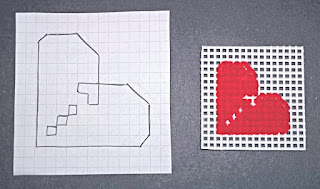| One od Annake;s many work bags |
Backgrounds can be fun to do and they can give your work a very modern look. There are a couple of things that you need to consider, however. You don't want the background to overwhelm your central motif. You can use use muted colors that complement the center design — light ones for a bright design or darker ones for a motif with a collection of pale colors, for example. Of course, as with all "rules", there are always exceptions. Take this "Screaming Eagle" picture for example, with its many background patterns and its diagonal arrangement of them.
The second thing to keep in mind is to slip your background stitches under the edge of the center design wherever they meet. This ensures that no empty canvas or background fabric shows through where it shouldn't. You can see a light-colored background with a bright-colored motif. Notice that there are no spaces between the motif and the background.
I'm going to do some samples of background patterns for you on plastic canvas because the stitches are fairly large and show up well in J.D.'s photographs. We will start with upright stitches because they are the easiest. I'm using small balls of leftover yarn that I store in egg cartons for practice or demonstration pieces. You can split or double such yarns to cover your canvas or even-weave fabric completely. I have used colors that have more contrast than I would usually use in a background so that it is easy to see what I am doing.
In the first sample the rows of stitches are the same size, with the different colors starting and finishing in the same squares of mesh. If the yellow rows look narrower than the orange ones, it is an optical illusion. In the second sample, however, the yellow rows are narrower than the orange ones, and in the last sample the yellow is a simple line of back-stitching between two rows of orange stitches. The differences are slight, but the results are subtle shifts. In each case, the yarn covers both sides of the canvas.
Now, instead of strips of color, I am going to use little blocks of two colors. Notice that the colors alternate on each row. This gives a checkerboard effect. No empty canvas shows because the stitches are placed right next to each other and the stitches in adjoining rows begin and end in the same squares of mesh.
The second set of red and blue blocks are made with stitches that slant upward and to the right. The first block stands alone at the beginning of the group, along with a small diagram of the stitches. (Unfortunately, many stitchery books are made for needle-workers with wide experience, and their diagrams may be difficult to decipher. I hope this simple one will be more useful.) The block looks a bit difficult at first, but, after doing a couple, you should find them easy and even fun. Use a separate needle for each color. This is the same checkerboard idea, but with somewhat different effects. This block is known as Scotch stitch. There are several variations, and we will see more of them as we go along.
Here is a good muted background made with closely related colors. Study the number of lines of stitches carefully to get the first couple of layers established. After that, it is just a matter of following the pattern upward or downward. The dark blue stitches show a single row of the design stitches so that you can see how the line is constructed. I would not use this pattern at a larger size unless I were working a fairly large design. The two lighter blues are appropriate for the background around a bright and colorful center design. The sample also shows you how to use partial blocks to even the top and bottom edges of the background. The second sample in the light blues shows a half-size pattern that would work with a smaller or more delicate design. I don't recommend using white in one of these backgrounds, but off-white, cream, or soft light grays and beige work well.
Here is an easy pattern of little diamonds in two or three colors. The third sample is done in a variegated gray yarn that gives a random all-over effect.
Here is a slightly more complex diamond pattern. Instead of three stitches to construct a diamond, we will use five stitches. Use different needles for the two colors. Look at the first light-colored diamond. The first stitch goes over two bars of plastic canvas, the second over four, and the third one over six. The fourth stitch is just like the second one and the fifth stitch is just like the first one. Work a row of the light-colored diamonds from left to right as I have done in the sample, leaving an empty row of canvas between them. Check each group of stitches as you make them and correct any mistakes. (It is easy to think: "That one is a little off, but nobody will notice it." I hate to disillusion you, but "that one" is exactly the one they will "zero in" on!)
Once the row is complete, work the row of darker color below the diamonds, starting in that empty square of mesh. After the row is complete, start working a row of light diamonds under the darker row. Don't worry about the first diamond in that row. You can fill it in later. Notice that the darker diamonds have a double stitch at top and bottom, with the two stitches sharing that empty square of mesh. Finish the darker row. By now you should know all you need to know about the pattern and can begin working across the top of the sample from right to left. This is a fairly large pattern and works up quickly. If you are looking for a pattern that is fast and fun, this one might be just the one you want!
Now I am going to use the Scotch blocks to make a pattern with more "movement" to it. Let's start with a solid block of one color at the upper left of the sample. (If you are left-handed, feel free to work any of these patterns in reverse.) Once that block is done, move your needle to the row of canvas just below the block and bring the needle up under the last stitch. Work an identical block, starting there. Continue to work the blocks in the same way until you have established a diagonal pattern of them. With a second color, work a block just below the top block in the series and all the blocks as far down as you have space for them. Continue in this fashion until you have used all the colors you want to use. Follow the sample. To finish the large square, continue making the blocks, but do the colors in the reverse order. In this case, yellow-green, medium green, and dark green.
This technique can also be used to make a rainbow of lines for an all-over design which stands alone rather than being used as a background for a central design. Here is a somewhat different version of the technique as a stand-alone project. Can you spot the differences?
As you find a design that works for you. it is a good idea to make a copy of it on canvas or even-weave fabric and save it in a large envelope or a box for future reference, whether you have used it or not.
These ideas for background treatments lend themselves to other kinds of craft-work as well. For example, see how the idea works for this latch-hook rug. Because rugs are made to be walked on, the background is darker than it would be for a picture or pillow, for example. The background for this rose rug involved closely related tones of gold.
I am rapidly running out of time and space for this issue, but I'm certainly not out of patterns! So let's consider this the beginning of a new series and I will add more issues on the subject from time to time.
Now, instead of strips of color, I am going to use little blocks of two colors. Notice that the colors alternate on each row. This gives a checkerboard effect. No empty canvas shows because the stitches are placed right next to each other and the stitches in adjoining rows begin and end in the same squares of mesh.
The second set of red and blue blocks are made with stitches that slant upward and to the right. The first block stands alone at the beginning of the group, along with a small diagram of the stitches. (Unfortunately, many stitchery books are made for needle-workers with wide experience, and their diagrams may be difficult to decipher. I hope this simple one will be more useful.) The block looks a bit difficult at first, but, after doing a couple, you should find them easy and even fun. Use a separate needle for each color. This is the same checkerboard idea, but with somewhat different effects. This block is known as Scotch stitch. There are several variations, and we will see more of them as we go along.
Here is a good muted background made with closely related colors. Study the number of lines of stitches carefully to get the first couple of layers established. After that, it is just a matter of following the pattern upward or downward. The dark blue stitches show a single row of the design stitches so that you can see how the line is constructed. I would not use this pattern at a larger size unless I were working a fairly large design. The two lighter blues are appropriate for the background around a bright and colorful center design. The sample also shows you how to use partial blocks to even the top and bottom edges of the background. The second sample in the light blues shows a half-size pattern that would work with a smaller or more delicate design. I don't recommend using white in one of these backgrounds, but off-white, cream, or soft light grays and beige work well.
Here is an easy pattern of little diamonds in two or three colors. The third sample is done in a variegated gray yarn that gives a random all-over effect.
Here is a slightly more complex diamond pattern. Instead of three stitches to construct a diamond, we will use five stitches. Use different needles for the two colors. Look at the first light-colored diamond. The first stitch goes over two bars of plastic canvas, the second over four, and the third one over six. The fourth stitch is just like the second one and the fifth stitch is just like the first one. Work a row of the light-colored diamonds from left to right as I have done in the sample, leaving an empty row of canvas between them. Check each group of stitches as you make them and correct any mistakes. (It is easy to think: "That one is a little off, but nobody will notice it." I hate to disillusion you, but "that one" is exactly the one they will "zero in" on!)
Once the row is complete, work the row of darker color below the diamonds, starting in that empty square of mesh. After the row is complete, start working a row of light diamonds under the darker row. Don't worry about the first diamond in that row. You can fill it in later. Notice that the darker diamonds have a double stitch at top and bottom, with the two stitches sharing that empty square of mesh. Finish the darker row. By now you should know all you need to know about the pattern and can begin working across the top of the sample from right to left. This is a fairly large pattern and works up quickly. If you are looking for a pattern that is fast and fun, this one might be just the one you want!
Now I am going to use the Scotch blocks to make a pattern with more "movement" to it. Let's start with a solid block of one color at the upper left of the sample. (If you are left-handed, feel free to work any of these patterns in reverse.) Once that block is done, move your needle to the row of canvas just below the block and bring the needle up under the last stitch. Work an identical block, starting there. Continue to work the blocks in the same way until you have established a diagonal pattern of them. With a second color, work a block just below the top block in the series and all the blocks as far down as you have space for them. Continue in this fashion until you have used all the colors you want to use. Follow the sample. To finish the large square, continue making the blocks, but do the colors in the reverse order. In this case, yellow-green, medium green, and dark green.
This technique can also be used to make a rainbow of lines for an all-over design which stands alone rather than being used as a background for a central design. Here is a somewhat different version of the technique as a stand-alone project. Can you spot the differences?
As you find a design that works for you. it is a good idea to make a copy of it on canvas or even-weave fabric and save it in a large envelope or a box for future reference, whether you have used it or not.
These ideas for background treatments lend themselves to other kinds of craft-work as well. For example, see how the idea works for this latch-hook rug. Because rugs are made to be walked on, the background is darker than it would be for a picture or pillow, for example. The background for this rose rug involved closely related tones of gold.
I am rapidly running out of time and space for this issue, but I'm certainly not out of patterns! So let's consider this the beginning of a new series and I will add more issues on the subject from time to time.
 This post by Annake's Garden is licensed under a Creative Commons Attribution-NonCommercial-ShareAlike 3.0 Unported License.
This post by Annake's Garden is licensed under a Creative Commons Attribution-NonCommercial-ShareAlike 3.0 Unported License.



























